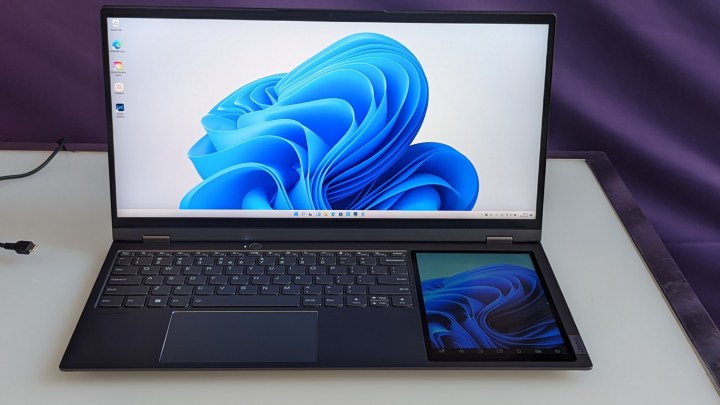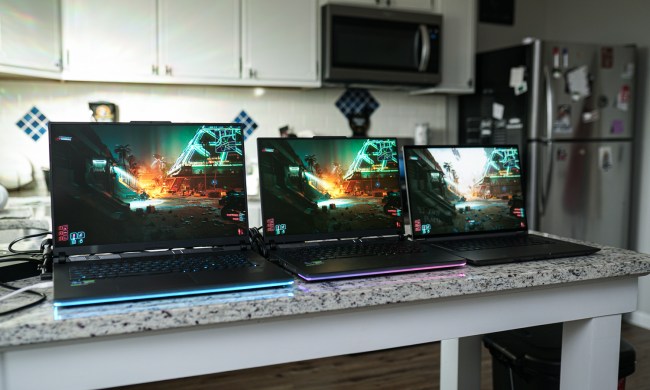Many of the best laptops make their debut at CES each year. Every manufacturer shows up to CES 2022 with what will be the biggest releases of 2022, many of which are flagship models that set the trends for laptops for 2022 and beyond.
Not including the best gaming laptops at CES, which devices have impressed us most at the show so far? These devices push the boundaries of laptop design in some fundamental way, and they provide a preview of laptop releases in 2022.

ThinkBook Plus Gen 3

Let’s start with the most attention-grabbing laptop of the show: Lenovo’s ThinkBook Plus Gen 3. The ThinkBook Plus first became famous for experimenting with e-ink displays on the back of the lid. But this year’s model tries for something even more unconventional: A tablet-sized screen built right into the deck of the keyboard!
To make it all fit, Lenovo had to stretch out the screen to an odd 21:10, making it nearly the shape of an ultrawide laptop. More than any other experiments with secondary laptop screens, though, Lenovo’s makes a remarkable amount of sense. Having a screen flat against the laptop is an ergonomically comfortable position to write or draw on. And since the system treats the secondary screen like a proper external display, you can use it for all kinds of different workflows and multitasking.
The only problem is that the flat angle of the second screen could be hard to see, depending on how you’re sitting. Still, it’s a highly conceptual laptop that
Asus Zenbook Fold 17

Another wild design this year is the Asus Zenbook Fold 17. It’s a tablet with a massive 17-inch foldable screen and a detachable Bluetooth keyboard. If that sounds familiar, it’s because it’s quite similar to 2020’s Lenovo ThinkPad X1 Fold. Except much bigger.
But the 17-inch size has a point. The larger screen makes for a far better laptop experience, which was one of the downfalls of the much smaller ThinkPad X1 Fold. Once you pop the keyboard onto the bottom half of the screen on the Zenbook Fold 17, you’re still left with a 12.5-inch screen to work with. That makes it a far more versatile laptop replacement.
The keyboard on the Zenbook Fold 17 also far surpasses other attempts at this, even offering a luxurious 1.4mm of key travel. It’s actually comfortable to type on, which might be the most surprising thing about this experimental piece of tech.
Dell XPS 13 Plus

Here’s one that came out of left field. The XPS 13 Plus is a brand new laptop from Dell that is both more powerful than the standard XPS 13 and decidedly more experimental in its design. Aside from the screen, every other element of the device has been revamped from the standard XPS 13. Notably, the traditional touchpad has been replaced by a borderless haptic feedback trackpad. And the function row of the keyboard? Gone, swapped in with capacitive touch buttons.
If those weren’t controversial enough, the XPS 13 Plus also does away with the headphone jack, leaving you with only two USB-C ports and wireless connectivity. To say this laptop is taking a lot of risks is to put it lightly.
Still, I have to admit I admire the brashness of the design. It feels like the future of laptops, even if all the kinks haven’t been worked out just yet.
HP Elite Dragonfly Chromebook

Yup, that’s right. A Chromebook. But the HP Elite Dragonfly Chromebook is no ordinary Chromebook. From what I’ve seen, it’s the most premium Chromebook ever made. The standard version of the Elite Dragonfly, recently announced to be in its third generation, is already one of the best business laptops you can buy, and bringing that amount of premium goodness to a Chromebook is a first.
The devil’s in the details, though. It’s the 5-megapixel webcam, the quad speakers, and even a Gorilla Glass haptic trackpad. But more than that, it offers an incredibly sharp 2256 x 1504 resolution, up to 32GB of RAM, and a 512GB SSD. Most of these specs are unheard of in a Chromebook.
The HP Elite Dragonfly Chromebook has the kind of polish we’ve simply never seen in a Chromebook, which makes it an obvious standout from CES so far.
Lenovo ThinkPad Z13 / Z16

Just when you think the ThinkPad brand couldn’t expand any further, Lenovo has announced yet another, the Z-series. If the X1 Carbon ThinkPads represented a modernization of the ThinkPad ethos, the ThinkPad Z13 and Z16 take it even a step further. While the TrackPoint nub remains, the left- and right-click buttons have been replaced by haptic feedback “ForcePad.”
But this is, of course, a business laptop first and foremost. That’s where the “Communications Bar” comes into play, which hosts a 1080p camera with a larger sensor, an electronic e-Shutter for privacy, and dual-array microphones. Laptops of the past hid these features as much as possible — but the ThinkPad Z13/16 emphasizes it. And for good reason.


